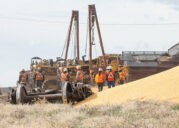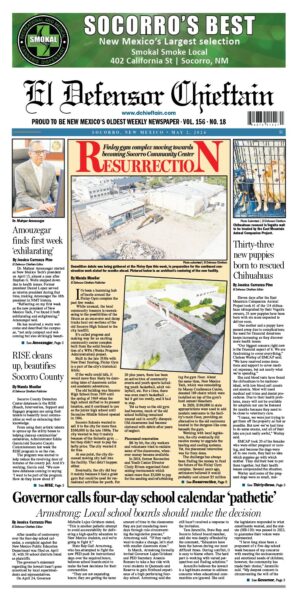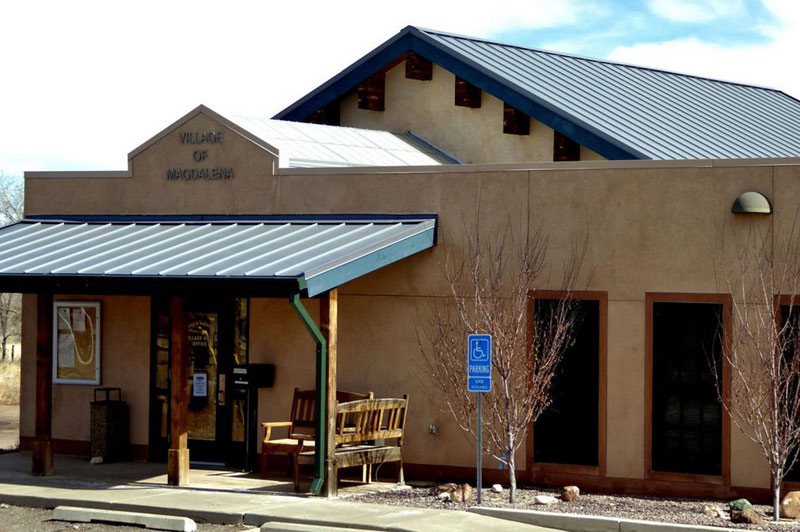
Cadet 2nd Lt. Zach Wyatt is all smiles after his glider flight with instructor John Chapman.
Russell Huffman | El Defensor Chieftain photos
Future aviators filled the skies last week over Socorro as the Civil Air Patrol and the U.S. Air Force conducted a 10-day-long glider academy to certify young pilots.
It was serious business for the cadets who were housed on the New Mexico Tech campus and got up at 4 a.m. in preparation for a rigorous day in the front seat of a glider while being accompanied by instructors in the backseat.
Before the cadets climbed into the pilot’s seat, they completed their ground studies and spent two days seated in the academy’s flying simulators.
“The first three days, we did it in a classroom. We have ground instructions and give them all the rules and regulations the FAA requires. Then we have simulators set up, and they fly those for a couple of days,” academy safety officer Dennis Hunter said.

A pair of cadet pilots in their gliders await their instructions in preparation for takeoff.
Hunter’s job is detail oriented as he oversees the workers on the airport’s runways and ensures everyone is ready to offer ground support as each glider lands and takes off. Socorro’s first-ever glider academy is in good hands.
“What we’re doing is we’re watching to make sure each aircraft is clear. We hook up the glider properly and ensure it takes off properly and lands properly,” Hunter said. “When we have multiple aircraft, and we have multiple gliders today. We have another guide that has been taken up to a couple of 1000 feet above the ground and turned loose. We keep the separation between the two aircraft.”
Because they are not engine-powered, gliders receive priority landings, so any aircraft flying into Socorro is put on hold until a flight has been completed.
There are multiple CAP glider academies across the country, and many of the cadets continue their CAP careers into adulthood while a nice percentage of them join the ranks of the service academies.
“Roughly 10 percent of the Air Force Academy cadets have been involved with the Civil Air Patrol,” public affairs officer Lt. Colonel Dave Finley said.
Air Force retiree Brad Oliver now works as a government service employee; before all that, he was also a CAP cadet.
“The CAP is the official auxiliary of the Air Force. We’re civilians. We don’t carry weapons. We don’t drop bombs. We don’t do anything like that but do civilian missions for the Air Force. For example, for aerial search and rescue in the US, you can use a C-138 at $10,000 bucks an hour, or you can use one of our planes at $160 bucks an hour,” Oliver said.
Success stories happen every day, as the CAP’s Doug Dutton explained.
“I run the same academy out in Kansas, and the 2021 honor graduate from this academy went on and got his pilot’s license last Saturday, and he left Monday for the Air Force Academy,” Dutton said. “We had another graduate who had thrown up a couple in the powered airplane, but he kept pushing. He ended up our honor graduate. He’s leaving this week for the Naval Academy.”
Powered aircraft is the ultimate goal for most cadets, while the instructors’ goals are to see that all of them become certified. There’s a little added pressure to do well with Lt. Colonel Roland Dewing, New Mexico’s Director of Aerospace Education, and the CAP’s state’s and southwest region’s glider coordinator on hand.
“We have nine cadets that are getting flight instructions. We hope to certify all of them by the end of the week,” Dewing said. “I’m proud that we have 3-4 staff cadets supporting and taking the time. We must keep track of time from takeoff.”

CAP cadet Daniel Gates gets ready for his glider’s tow hook.
As Dewing talks, time runs out for cadet 2nd Lt. Zach Wyatt, who is approaching for landing. Wyatt is rock-solidly supported by 50 years of John Chapman’s flying instruction as the 76-year-old watches and evaluates his every move.
It was Wyatt’s second flight in the glider, and he’s feeling confident.
“I was way more comfortable than I was on the first flight. It’s just doing what the trainer says,” Wyatt said.
The smile on the young man’s face is a mile wide and infectious. He’s ready to get back into the sky as quickly as possible and promptly gets his wish. The two don’t leave their aircraft because they are headed back into the skies above Socorro again as Wyatt receives the opportunity to immediately absorb his instructions and put them to the test.
“I’m looking for smoothness, precision control, and that he can hold his spot. He’s a very good tow pilot, but he’s learning a couple of other things,” Chapman said. “Each one requires a step of learning Nothing is automatic, but everything here is easy to do once you’ve learned it.”
Los Alamos’ Michael Bane is one of this year’s ground crew, and he’s giving back to the CAP after getting glider-certified last year.

Los Alamos resident Michael Bane is one of this year’s ground crew, and he’s giving back to the CAP after getting glider-certified last year.
It was a fantastic experience. I really enjoyed it. I enjoyed the glider more than the powered flight. With the glider it was, I felt like it was simpler – like I was part of the aircraft. You could enjoy the flight more. Instead of worrying about power, you just had the glider, and you were coasting along. It was nice and peaceful, nice and quiet,” Bane said.
Released at about 2,500 feet above the ground, a glider pilot’s flight can last 10-20 minutes depending on the mission, the flyer’s skill level and weather conditions. No matter the length of the flight, the cadet must always keep the airport in visual sight.
Five flights into his glider career, cadet Daniel Gates has started to get comfortable behind his aircraft’s stick, and each orbit has added another level to his confidence.
“It’s a unique experience, and once you start doing it, you want to keep doing it, and it’s great to fly. It’s awesome,” Gates said.
Gates’ instructor Victor Jones started his glider career in the United Kingdom and is now based in Oklahoma. His evaluations will determine when Gates is ready to solo the aircraft.
“We want to see a pilot demonstrate his knowledge of the rules of the air,” Jones said. “Then there’s energy management. You must maintain situational awareness of what’s happening all the time. It’s quite difficult for the guys to stay put in position behind the tow; if they have problems, I’ll just take control, put it back in position, and then they’ll get it for a little while.”
The academy’s nine cadets can become certified gliders and power aircraft pilots without cost. You must be a CAP cadet to earn the chance. There is no obligation to join the military.
“You must join the Civil Air Patrol and be a cadet member to do it. There’s no obligation to join the military or anything. Part of the deal is that the Air Force funds this, and it’s a reaction to the severe pilot shortage in this country,” Finley said.
If you’d like to learn more about the Civil Air Patrol Socorro Composite Squadron, check out their Facebook page at https://www.facebook.com/socorrocivilairpatrol.






















